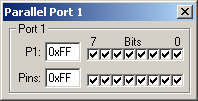|
||
| Products Download Events Support Videos | ||
Product Information
Device Database®
Downloads
Compliance Testing
Distributors
Peripheral Simulation
For NXP (founded by Philips) P83/87C660X2 — Port 1
Simulation support for this peripheral or feature is comprised of:
- Dialog boxes which display and allow you to change peripheral configuration.
- VTREGs (Virtual Target Registers) which support I/O with the peripheral.
These simulation capabilities are described below.
Parallel Port 1 Dialog

This dialog displays the SFR and pins of Port 1.
- P1: This is the P1 SFR. The HEX value and value of each bit is displayed and may be changed from this dialog.
- Pins: These are the states of the pins on the simulated MCU. When used as outputs, these have the same value as the P1 SFR. When used as inputs (P1.x is 1) you may set the level of the input pin to high (1) or low (0).
The PORT1 VTREG may be used (from the Command Window or from a user or signal function) to affect the input values of the simulated pins of Port 1.
PORTx VTREG
Data Type: unsigned char
The PORTx VTREGs represent the I/O pins of the simulated MCU for Port 0, Port 1, and so on. PORT0 represents Port 0, PORT1 represents Port 1, etc. You may read PORTx to determine the state of the output pins of that port. For example, in the command window, you may type,
PORT0
to obtain value corresponding to the set pins of Port 0. You may also change the input values of port pins by changing the value of the VTREG. For example,
PORT1=0xF0
sets the upper four port pins of Port 1 to a value of 1 and the lower 4 port pins to a value of 0. You may use the bitwise operators AND(&), OR(|) and XOR(^) to change individual bits of the PORTx VTREGs. For example:
PORT1 |= 0x01; /* Set P1.0 Pin */ PORT3 &= ~0x02; /* Clr P3.1 Pin */ PORT1 ^= 0x80; /* Toggle P1.7 Pin */
ProductsDevelopment Tools |
Hardware & Collateral |
Downloads |
Support |
Contact |
